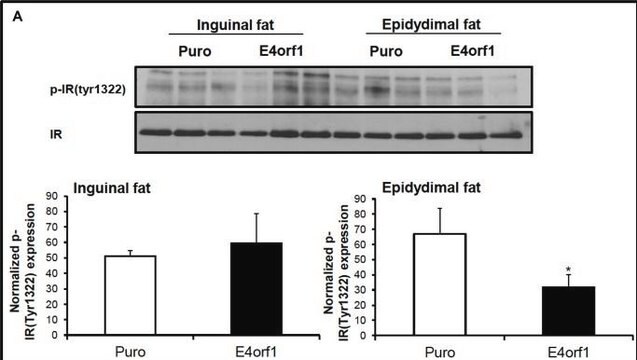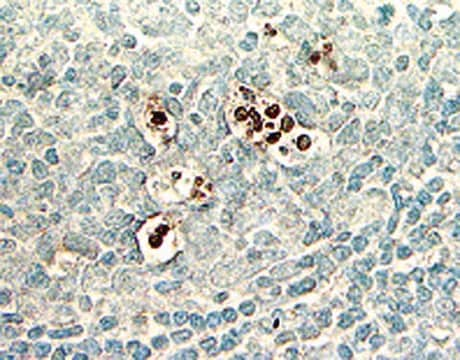04-299
Anti-phospho-Insulin Receptor (Tyr 1150/1151) Antibody, clone 10C3
clone 10C3, Upstate®, from mouse
Synonym(s):
INSR
Sign Into View Organizational & Contract Pricing
All Photos(1)
About This Item
UNSPSC Code:
12352203
eCl@ss:
32160702
NACRES:
NA.41
Recommended Products
biological source
mouse
Quality Level
antibody form
purified antibody
antibody product type
primary antibodies
clone
10C3, monoclonal
species reactivity
human
manufacturer/tradename
Upstate®
technique(s)
activity assay: suitable
western blot: suitable
isotype
IgG1
NCBI accession no.
UniProt accession no.
shipped in
wet ice
target post-translational modification
phosphorylation (pTyr1150/pTyr1151)
Gene Information
human ... INSR(3643)
Specificity
Recognizes phosphorylated domain of Insulin receptor on Tyrosine 1150/1151.
Immunogen
KLH-conjugated synthetic peptide encompassing the surrounding amino acids of Tyrosine 1150/1151 on phosphorylated insulin receptor.
Application
Detect phospho-Insulin Receptor (Tyr 1150/1151) using this Anti-phospho-Insulin Receptor (Tyr 1150/1151) Antibody, clone 10C3 validated for use in EA & WB.
Quality
Routinely evaluated by immunoblot.
Target description
97 kDa
Physical form
Format: Purified
In 1 mL of PBS containing 0.09% sodium azide, PEG, and sucrose and 50% glycerol.
Analysis Note
Control
Includes pervanadate treated HEK293 lysate as a positive control
Includes pervanadate treated HEK293 lysate as a positive control
Legal Information
UPSTATE is a registered trademark of Merck KGaA, Darmstadt, Germany
Not finding the right product?
Try our Product Selector Tool.
Storage Class Code
10 - Combustible liquids
Certificates of Analysis (COA)
Search for Certificates of Analysis (COA) by entering the products Lot/Batch Number. Lot and Batch Numbers can be found on a product’s label following the words ‘Lot’ or ‘Batch’.
Already Own This Product?
Find documentation for the products that you have recently purchased in the Document Library.
Natalie N Rizk et al.
Fertility and sterility, 86(4 Suppl), 1217-1222 (2006-09-12)
To determine whether the insulin receptor (IR), insulin-like growth factor-I receptor (IGF-IR), and IGF-I are expressed differentially in fibroblasts isolated from normal peritoneal and adhesion tissue before and after 24-hour treatment with increasing glucose concentrations. Prospective experimental study. University medical
Qiu-yan Wang et al.
The FEBS journal, 274(2), 526-538 (2007-01-19)
Two H7721 human hepatocarcinoma cell lines showing moderate and high expression of alpha1,3-fucosyltransferase (FucT)-VII cDNA were established and designated FucTVII-M and FucTVII-H, respectively. In alpha1,3-FucT-VII-transfected cells, expression of insulin receptor (InR) alpha- and beta subunits and epidermal growth factor receptor
Atsumi Tsuji-Hosokawa et al.
Pediatric diabetes, 18(8), 917-924 (2017-02-10)
Defects of the insulin receptor gene ( INSR ) cause wide spectra of congenital insulin resistance. Monoallelic defects result in milder insulin-resistant diabetes mellitus with acanthosis nigricans (IRAN, type A). Whereas, leprechaunism (Donahue syndrome), the most severe condition with lethality
Rita Slaaby et al.
The Journal of biological chemistry, 281(36), 25869-25874 (2006-07-13)
Insulin receptor (IR) and insulin-like growth factor I receptor (IGF-IR) are both from the same subgroup of receptor tyrosine kinases that exist as covalently bound receptor dimers at the cell surface. For both IR and IGF-IR, the most described forms
Our team of scientists has experience in all areas of research including Life Science, Material Science, Chemical Synthesis, Chromatography, Analytical and many others.
Contact Technical Service








